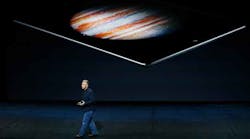SAN FRANCISCO — Apple is bolstering its money-pumping iPhone line while looking to dive deep into businesses with iPads and dominate living rooms with Apple TV hardware tuned to app-loving lifestyles.
Tricked-out new iPhone 6 models, along with overhauled Apple TV hardware and iPad Pro tablets with enlarged screens, were major announcements at the technology titan’s media event Wednesday in San Francisco.
“Apple did the typical good job at the event,” Gartner analyst Brian Blau told AFP. “Overall, I don’t think it is going to push the needle for Apple in a good or a bad direction. These are great devices and cool features.”
Apple shares ended the official trading day down slightly less than 2% at $110.15, and danced around that price in after-market trades.
“If you are an investor, you are probably not that excited about today because you didn’t hear numbers and these features won’t impact sales this quarter,” Blau said.
The iPhone 6S, with 3-D Touch: Apple introduced two updated iPhones to build on the success of large-screen handsets introduced last year that have dominated the high-end smartphone market. The iPhone 6S and 6S Plus have the same overall dimensions as the previous versions, but with new technologies under the hood.
One of the key new features is called “3-D touch,” which responds to pressure exerted on the screen to allow users to look inside messages and applications.
“Apple has performed the ultimate conjuring trick: Change everything about the iPhone, but make it look almost identical to the old model,” IHS Technology said in a posted analysis.
By responding to sensing pressure, the phones enable users to dip in and out of content without losing their place.
“It will further refine our use of touch as a main user interface,” Blau said.
The 6S has the 4.7-inch display of its predecessor and the 6S Plus — which updates one of the more popular handsets in the “phablet category” — has the same 5.5-inch screen. But the devices have more powerful processors that allow for improved graphics, harder glass and a new aluminum body. Pricing will be kept at the same levels as the earlier versions.
For those buying without carrier subsidies, Apple will sell the devices on a 24-month installment plan at $27 per month for the $650 iPhone 6S and $31 for the 6S Plus, making the price nearly $750.
Apple will take pre-orders starting Saturday and deliver the phones September 25 in the United States, Great Britain, Australia, Canada, China, France, Germany, Hong Kong, Japan, New Zealand, Puerto Rico and Singapore.
The iPad Pro (with Pencil?!): The new iPad Pro has the power and capabilities to replace a laptop computer, Apple said. It had aspects reminiscent of Microsoft Surface Pro tablets, such as covers that double as keyboards.
Apple CEO Tim Cook called the device “the biggest news in iPad since the iPad.” The new tablet with a 12.9-inch display also includes a detachable keyboard and stylus, sold separately.
According to Apple senior vice president Phil Schiller, the device features “desktop-class performance” and operates faster than 80% of portable PCs that shipped in the last 12 months.
The new iPad will be available in November starting at $799.
The iPad Pro stylus, called Apple Pencil, was designed for high-precision illustration and 3-D design applications. Apple Pencil will be sold for $99 more and the keyboard for $169.
Avi Greengart at the research firm Current Analysis tweeted that the new tablets “are aimed directly at enterprises. That’s a long sales cycle, but could finally stop (the tablet market’s) sales slide.”
Apple TV: Upgraded Apple TV includes voice search, touchscreen remote control and an app store in a challenge to Google, Amazon and Roku. Apple TV was overhauled as people increasingly stream films and television shows on-demand online and turn to mobile applications for entertainment.
“We believe the future of television is apps,” Cook said.
Apple released a software kit for outside developers, and showed off early versions of Apple TV applications already being crafted by show streaming services Netflix and Hulu, as well as HBO. Apple TV has the potential to take the kinds of “casual game” apps popular on mobile devices and put them on television screens, according to analysts.
Siri virtual assistant software newly built into Apple TV will allow for natural language searches for shows – for example, by asking for something funny or a certain actor by name.
The new Apple TV will launch in late October at a starting price of $149. Apple TV has lagged rivals with similar devices.
According to the research firm Parks Associates, Roku leads the US market with a 37% market share, to 19% for Google Chromecast and 17% for Apple TV. Amazon’s Fire TV devices have 14%. “For Apple TV to succeed it will have to give people what they already want on a TV: TV shows,” Forrester analyst James McQuivey said.
And, finally, WatchOS 2: Apple also said the operating system for its Apple Watch, watchOS 2, would be made available as a free update September 16.
The company offered no sales figures but Cook said customers “love using Apple Watch,” and that user satisfaction “is an incredible 97%.”
The latest iteration of the Watch, created with French fashion house Hermes, features a hand-stitched leather band and starts at $1,100.
Copyright Agence France-Presse, 2015




